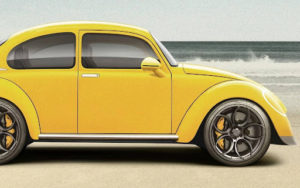The Volkswagen Beetle appeared in the 30s as a mass-produced and affordably owned car for the general public. Intended to be a “people’s car” (in German, “Volkswagen”), it was dramatically influenced by the designs of American automobiles of the time, such as the Ford Model T.

Known also as the VW Bug, the Beetle was first designed in the 1930s by Ferdinand Porsche at the request of the Nazzi Government. However, few know that at first the Jewish engineer was initially involved in the project. Nevertheless, Hitler dismissed him and gave the project to Porsche who finished the vehicle eventually making it the automotive icon whose resounding success echoes until today.
The History Of “Maikäfer”

In 1934, Hitler commissioned the famous designer Ferdinand Porsche to design a mass-produced and easy-to-maintain cheap “people’s car” for each German working family. They called the project Volkswagen (“People’s Car”). But few people know that back in 1931, the editor-in-chief of the German auto magazine Motor-Kritik and auto designer Josef Ganz developed 30 prototypes of compact vehicles, one of which was called Maikäfer (“May Beetle”).
In 1933, Ganz introduced the model Superior, designed for Standard company. The automobile was equipped with a rear-mounted two-cylinder engine, a tubular frame, and independent suspension on all wheels. For Standard’s Superior commercial the slogan “people’s car,” first appeared.
In the same year, the automobile was shown at the International Auto and Motorcycle Exhibition in Berlin. Hitler liked the Superior model, and the company’s management appointed Josef Ganz to lead the Volkswagen project. However, the Nazis could not allow a “people’s car” to be designed by a Jew. The designer was suspended from work, Standard was banned from using the word Volkswagen, and Motor-Kritik magazine was declared a “Jewish fake.” After being summoned for interrogation by the Gestapo, Ganz fled abroad. The project was given to renowned auto designer Ferdinand Porsche.
Porsche’s Beetle

Ferdinand Porsche set to work right in his company’s Stuttgart plant, converting two adjoining garages into a workshop. The manufacture of the main components was entrusted to specialized factories, the rest was done by the staff on the spot.
Additionally, several key people worked closely with Porsche on the development of the Beetle, including Karl Rabe, who was responsible for body design, and Erwin Komenda, who designed the Beetle’s distinctive shape. The vehicle turned out to be rear-wheel drive, unusual for that time. So, in December 1934, three automobiles of the V3 series were assembled. They embodied the most successful design solutions and were used for basic road tests.
At the 1935 Motor Show, Hitler declared in his speech that “the eminent designer Porsche, and his bureau, had succeeded in creating a German people’s car, the first samples of which will be ready for testing in the middle of 1935.” On February 15, 1936, the Fuhrer announced the start of the Volkswagen Beetle production, the “people’s car” that went down in history as the Beetle.
From Banned Nazzi Automobile To An Automotive Icon

To make the people’s car available to everyone, the Nazi government announced a subscription for the purchase of a new model and the collection of preliminary contributions. However, in vain 336 thousand Germans were waiting for their Beetle. In 1939, the Nazi regime unleashed World War II.
The Beetle plant had to urgently redesign to produce all-terrain army vehicles, wheels for tanks, and then missiles. Several years later, instead of enjoying the benefits of the Nazi social system, German workers and war prisoners became forced laborers in the occupied territories. At the end of the war, Volkswagen suffered the same fate as most German industrial enterprises: allied bombing razed almost all factory buildings to the ground.
Fortunately, in 1945, the British, who needed vehicles, allowed the production of vehicles to resume here. Moreover, during the 1960s, the Beetle became the best-selling foreign automobile in the United States. It was produced with various modifications, becoming the basis of many other models. In 1972, the number of sold vehicles exceeded 15 million! The last vehicle, identical to the one produced in 1945, rolled off the assembly line in Mexico in 2003 with serial number 21,529,464. And in 2018, Volkswagen announced the final cessation of production of the legendary “Beetle”.
If you like this article, please share it with your friends.

